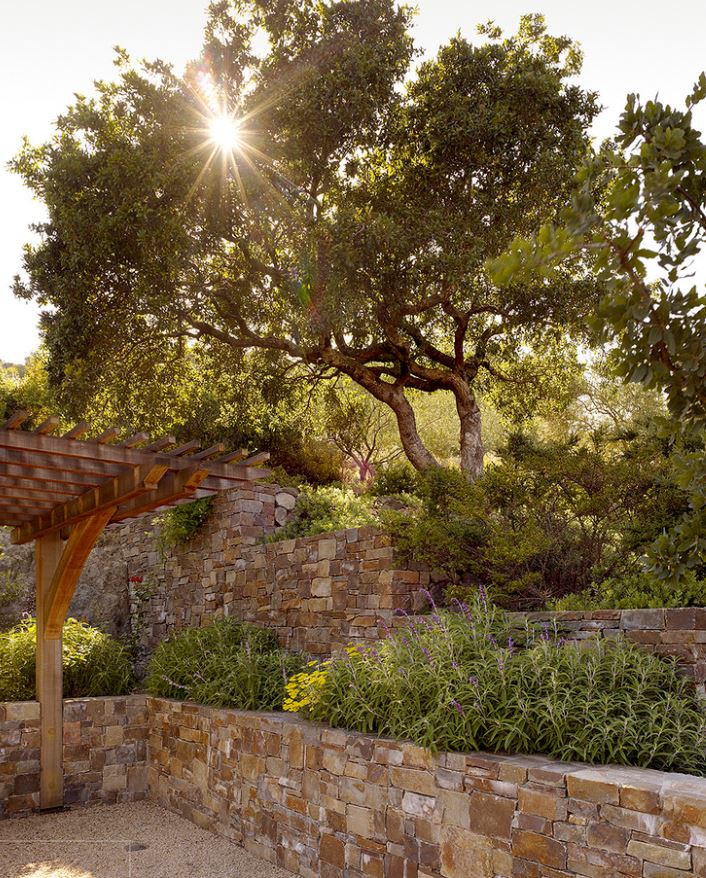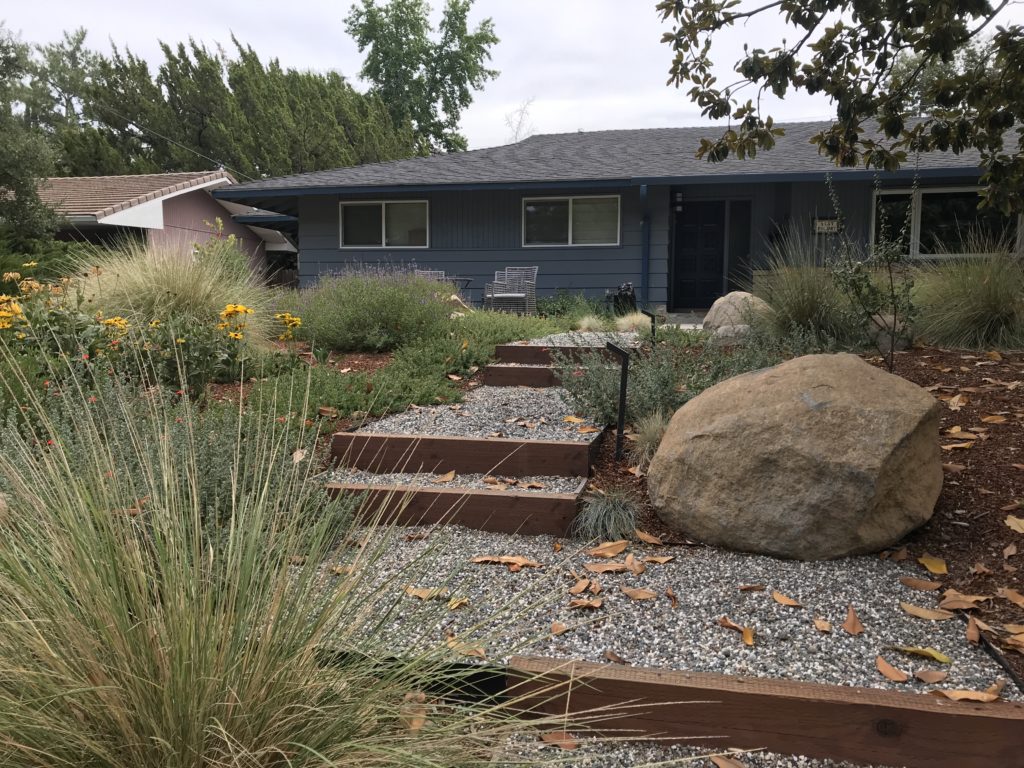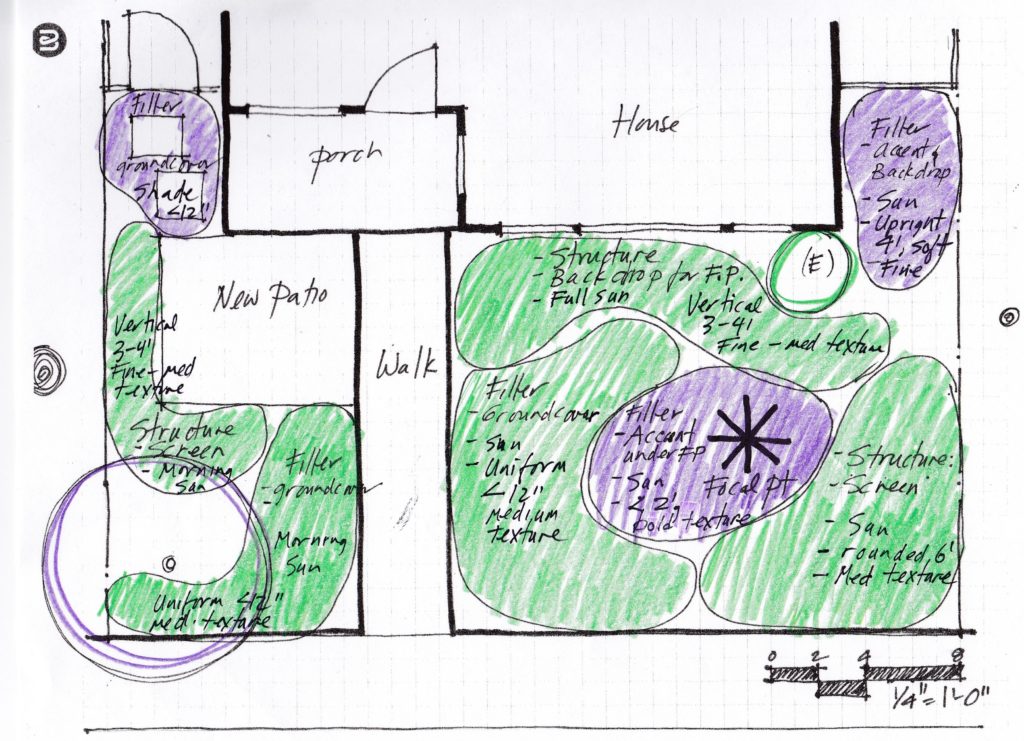Site map and analysis completed, per Part One? Check! Garden style selected, per Part Two? Check! Welcome to Part Three of Basic Planting Design, where the focus is: What plant jobs need to be filled in my garden? Plants jobs can be functional, aesthetic, or both!
Functional jobs affect the use of the garden. The metaphor for the functional uses of plants is
architectural: Trees act as the “roof” of the garden, providing shade and large-scale screens, framing views, creating micro-climates, and providing food for humans and wildlife alike. Shrubs are the garden’s “walls” that define spaces, add lower level privacy screening and structural elements, and provide a background for focal points. Ground covers are the garden “floor” that stabilizes the soil against erosion, reduces soil temperatures, and slows evaporation rates.
Aesthetic jobs affect the sensory aspects of a garden. These are primarily visual influences but also include scent, sound, and touch. Pleasing plant designs take into consideration the attributes of texture, form, and color and the use of the principles of rhythm, line, balance, contrast, and unity to apply these attributes.
- A plant’s texture describes the size of its foliage and flowers and ranges from coarse to fine. Drifts of fine-textured plants tend to make the spaces in which they are planted seem larger. Bold textured plants add flair to a garden.
- When referring to an entire plant, form describes its overall shape and stature. Plants with bold horizontal or vertical lines or strong visible branching are highly structural. They visually anchor a garden and add drama. Plants with rounded or billowy shapes contrast with and soften structural plants. Form also describes the varied shapes of individual flowers, including spires, balls, umbels, spires, plumes, daisy-like, and curtains. Drifts of
contrasting flower forms add interest to a garden.
- Infinite color palettes that can be created with foliage and flower color. Foliage offers long term color, while flowers provide their hues in shorter bursts. Plant color palettes can be generally categorized as “cool” or “warm.” Cool palettes mingle purples, blues, grays, pinks that have blue undertones, and pure- or greenish-yellows. Reds, bronzes, and oranges create a warm palette. Pinks with red undertones and orangey yellows also go with a warm palette.
Color palettes can also be monochromatic, combining plants with foliage and flower colors in a single color such as red, yellow or blue/gray. Plant red, yellow, and blue together, and you have a garden in “primary” colors! And remember, green, in all of its various shades, is a color.
- Repetition of any or all of the three attributes (texture, form, and color) creates rhythm in a garden. Gentle contrasts between texture and form and a monochromatic color palette make for subtle rhythm. For pizzazz, bump up the contrast between form and texture or use vivid colors.
- Line is used to emphasize garden style and create directional cues. Plantings and hardscape can be used to create lines that lead the eye through a garden. For example, the line of a path or converging lines of plantings draw the eye to a focal point while curving paths, with
destinations that are hidden by plants, invite the curious to explore a garden.
- In design, Balance is the principle of distributing visual weight equally. Plant mass and color both affect balance. In a symmetrically balanced garden, opposing areas are mirror images of each other with similar plantings used on either side. In an asymmetrically balanced garden, unlike elements can balance each other. For example, a single strongly structural plant can be balanced with a boldly colored mass of filler plants.
- Contrast and unity are partners in well-designed gardens. Interesting gardens require contrast while unity ties it all together. To achieve unified contrast, follow the 2:1 guideline: Select any two of the plant attributes (texture, form and color) to create either unity or contrast. The third attribute will oppose the other two. For instance, contrast texture and form while using color to unify the overall scheme. Such a garden could feature bold and fine textured plants, highly structural plants and blowsey filler plants, and a monochromatic color palette. Applying the principles of rhythm, line, and balance will further unify the design.
Now, it’s back to the drawing board: time to develop your preliminary planting plan! To stay on track, refer to your site analysis (per Part One), and stick to your style preferences (per Part Two). Start loose and tighten up the plan as you progress.
For this phase, think about plant functions rather than individual plants. Start by loosely bubbling (outlining) the shape and location of structural plant masses. Then bubble in the location and shape of filler plant masses. Within each bubble, note the plant function (shade tree, screen plant, accent), the cultural conditions, and whether the plant(s) are to be evergreen or deciduous. Next, think about which plant attributes you want to use to provide contrast and which you want to provide unity. Assign texture and form attributes to each of the bubbles, keeping in mind the 2:1 guideline. Double check to see that you have arranged the plant attributes to provide rhythm, line, and balance in a way that reinforces your garden style.
Your completed preliminary planting plan will show separate bubbles labeled with plant form, function, cultural conditions, foliage type (evergreen or deciduous) and plant attributes.
Stay tuned for our final and fourth guiding question: Is my yard ready to plant? Happy Gardening!
Thank you to Master Gardener Laura Lukes for her invaluable assistance in preparing this article!



